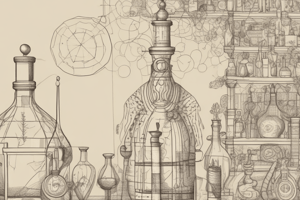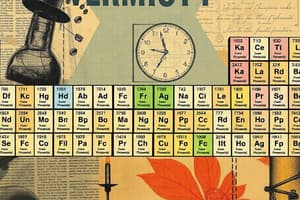Podcast
Questions and Answers
What unique property of water allows ice to float above liquid water?
What unique property of water allows ice to float above liquid water?
Ice floats above liquid water due to the fact that it is less dense than liquid water, which is a result of the hydrogen bonds in the water molecules.
What is the capacity of water to absorb energy called?
What is the capacity of water to absorb energy called?
The capacity of water to absorb energy is called specific heat capacity, which is higher than that of other solvents such as ethanol.
What is the pH of pure water?
What is the pH of pure water?
The pH of pure water is neutral, as the number of hydrogen ions balances the number of hydroxyl ions.
What are organic compounds?
What are organic compounds?
How many atoms can carbon form covalent bonds with?
How many atoms can carbon form covalent bonds with?
What is the simplest form of an organic molecule?
What is the simplest form of an organic molecule?
What did the Miller-Urey experiment demonstrate?
What did the Miller-Urey experiment demonstrate?
What are macromolecules made up of?
What are macromolecules made up of?
What is biology?
What is biology?
What are the unifying themes of biology?
What are the unifying themes of biology?
What levels of organization can biologists study life at?
What levels of organization can biologists study life at?
How do biologists use the scientific method in their research?
How do biologists use the scientific method in their research?
Who improved the microscope, leading to discoveries in microscopic life?
Who improved the microscope, leading to discoveries in microscopic life?
Who emphasized the importance of the cell and consolidated the cell theory in the 19th century?
Who emphasized the importance of the cell and consolidated the cell theory in the 19th century?
Who proposed the possibility of common descent in taxonomy and classification?
Who proposed the possibility of common descent in taxonomy and classification?
Who began evolutionary thinking and was further developed by Charles Darwin and Alfred Russel Wallace?
Who began evolutionary thinking and was further developed by Charles Darwin and Alfred Russel Wallace?
What reconciled Darwinian evolution with classical genetics in the early 20th century?
What reconciled Darwinian evolution with classical genetics in the early 20th century?
What marked the transition to the era of molecular genetics in the 1950s?
What marked the transition to the era of molecular genetics in the 1950s?
What was launched in 1990 to map the human genome?
What was launched in 1990 to map the human genome?
What are the four chemical elements that account for most of the mass in organisms?
What are the four chemical elements that account for most of the mass in organisms?
What do biochemistry and molecular biology seek to understand?
What do biochemistry and molecular biology seek to understand?
What makes water essential for life and serves as an effective solvent?
What makes water essential for life and serves as an effective solvent?
Match the following properties with their descriptions:
Match the following properties with their descriptions:
Match the following organic compounds with their characteristics:
Match the following organic compounds with their characteristics:
Match the following terms with their definitions:
Match the following terms with their definitions:
Match the following themes in biology with their descriptions:
Match the following themes in biology with their descriptions:
Match the following subdisciplines within biology with their defining characteristics:
Match the following subdisciplines within biology with their defining characteristics:
Match the following scientific methods with their descriptions:
Match the following scientific methods with their descriptions:
Match the following forms of life with their classification:
Match the following forms of life with their classification:
Match the following historical figures with their contributions to biology:
Match the following historical figures with their contributions to biology:
Match the following eras with their significance in biology:
Match the following eras with their significance in biology:
Match the following scientific fields with their focus in biology:
Match the following scientific fields with their focus in biology:
Flashcards are hidden until you start studying
Study Notes
History and Chemical Basis of Biology
- The history of biology traces back to ancient Egypt and Mesopotamia, with significant contributions from Greek philosophers like Aristotle and Theophrastus.
- Islamic scholars in the medieval period made significant contributions to the study of biology, particularly in the fields of medicine and natural history.
- The development of biology was greatly influenced by the improvement of the microscope by Anton van Leeuwenhoek, leading to discoveries in microscopic life.
- In the 19th century, the importance of the cell was emphasized, and the cell theory was consolidated, focusing on the fundamental unit of organisms.
- Taxonomy and classification became a key focus, with Carl Linnaeus publishing a basic taxonomy and Georges-Louis Leclerc proposing the possibility of common descent.
- Evolutionary thinking began with Jean-Baptiste Lamarck and was further developed by Charles Darwin and Alfred Russel Wallace, leading to the theory of natural selection.
- The modern synthesis in the early 20th century reconciled Darwinian evolution with classical genetics, laying the foundation for modern genetics.
- The discovery of DNA as the component of chromosomes and the double-helical structure of DNA marked the transition to the era of molecular genetics in the 1950s.
- The genetic code was cracked in the 1960s, and the Human Genome Project was launched in 1990 to map the human genome.
- All organisms are composed of chemical elements, with oxygen, carbon, hydrogen, and nitrogen accounting for most of the mass, and water being fundamental to life.
- Biochemistry and molecular biology seek to understand the chemical processes and molecular basis of biological activity in organisms.
- Water's molecular structure, properties, and abundance make it essential for life, serving as an effective solvent and participating in chemical reactions that sustain life.
History and Chemical Basis of Biology
- The history of biology traces back to ancient Egypt and Mesopotamia, with significant contributions from Greek philosophers like Aristotle and Theophrastus.
- Islamic scholars in the medieval period made significant contributions to the study of biology, particularly in the fields of medicine and natural history.
- The development of biology was greatly influenced by the improvement of the microscope by Anton van Leeuwenhoek, leading to discoveries in microscopic life.
- In the 19th century, the importance of the cell was emphasized, and the cell theory was consolidated, focusing on the fundamental unit of organisms.
- Taxonomy and classification became a key focus, with Carl Linnaeus publishing a basic taxonomy and Georges-Louis Leclerc proposing the possibility of common descent.
- Evolutionary thinking began with Jean-Baptiste Lamarck and was further developed by Charles Darwin and Alfred Russel Wallace, leading to the theory of natural selection.
- The modern synthesis in the early 20th century reconciled Darwinian evolution with classical genetics, laying the foundation for modern genetics.
- The discovery of DNA as the component of chromosomes and the double-helical structure of DNA marked the transition to the era of molecular genetics in the 1950s.
- The genetic code was cracked in the 1960s, and the Human Genome Project was launched in 1990 to map the human genome.
- All organisms are composed of chemical elements, with oxygen, carbon, hydrogen, and nitrogen accounting for most of the mass, and water being fundamental to life.
- Biochemistry and molecular biology seek to understand the chemical processes and molecular basis of biological activity in organisms.
- Water's molecular structure, properties, and abundance make it essential for life, serving as an effective solvent and participating in chemical reactions that sustain life.
Studying That Suits You
Use AI to generate personalized quizzes and flashcards to suit your learning preferences.





